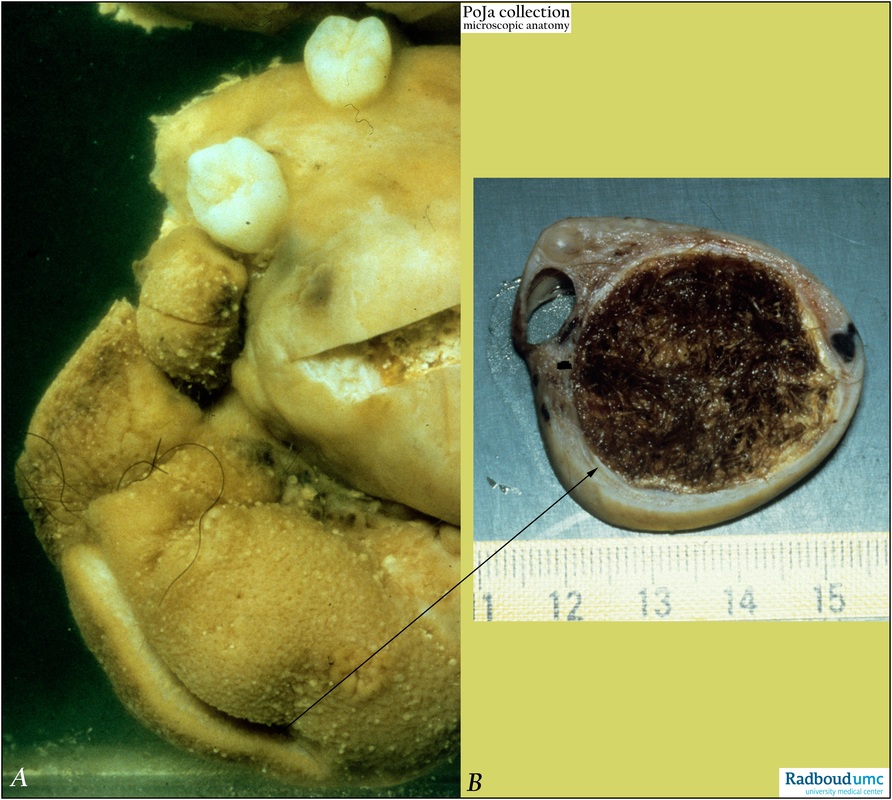7.1 POJA-L1486+1487
Title: Mature cystic teratoma, ovary (human, adult)
Description: Macroscopy.
(A) The teratoma tumor is covered with epidermis, few long black hairs. Note the two well developed teeth.
(B) The black arrow points from the bottom incision in (A) to a cross-section in (B) showing an indefinable dark sebum-like hairy content. (By courtesy of G. P. Vooijs MD, PhD, former Head of the Department of Pathology, and the Museum of Anatomy and Pathology, Radboud university medical center, Nijmegen, The Netherlands).
Background: Teratomas are mostly benign cystic tumors, clinically called dermoid cysts varying in size between 5 and 15 cm. They are usually detected in women during active reproductive years and found bilaterally in 10-15% of the cases. These tumors are germ cell neoplasms and the current parthenogenetic theory suggests origin from a meiotic germ cell. It is therefore suggested that these tumors arise from an ovum after the first meiotic division. They contain displaced ectodermal structures along the line of embryonic fusion resulting in the presence of a mixture of variable tissues. Generally the teratoma cysts are lined by slightly keratinized squamous epithelium, connective tissue and skin appendages or respiratory epithelium and contain sebaceous material and hairs. Hair shafts protrude from the epidermis and tooth structures and calcified areas are often found within the wall.
Keywords/Mesh: female reproductive organs, ovary, dermoid cysts, female genitalia, ovarian neoplasms ovarian teratoma, tumor, macrosscopy, pathology, teeth, histology, POJA collection
Title: Mature cystic teratoma, ovary (human, adult)
Description: Macroscopy.
(A) The teratoma tumor is covered with epidermis, few long black hairs. Note the two well developed teeth.
(B) The black arrow points from the bottom incision in (A) to a cross-section in (B) showing an indefinable dark sebum-like hairy content. (By courtesy of G. P. Vooijs MD, PhD, former Head of the Department of Pathology, and the Museum of Anatomy and Pathology, Radboud university medical center, Nijmegen, The Netherlands).
Background: Teratomas are mostly benign cystic tumors, clinically called dermoid cysts varying in size between 5 and 15 cm. They are usually detected in women during active reproductive years and found bilaterally in 10-15% of the cases. These tumors are germ cell neoplasms and the current parthenogenetic theory suggests origin from a meiotic germ cell. It is therefore suggested that these tumors arise from an ovum after the first meiotic division. They contain displaced ectodermal structures along the line of embryonic fusion resulting in the presence of a mixture of variable tissues. Generally the teratoma cysts are lined by slightly keratinized squamous epithelium, connective tissue and skin appendages or respiratory epithelium and contain sebaceous material and hairs. Hair shafts protrude from the epidermis and tooth structures and calcified areas are often found within the wall.
Keywords/Mesh: female reproductive organs, ovary, dermoid cysts, female genitalia, ovarian neoplasms ovarian teratoma, tumor, macrosscopy, pathology, teeth, histology, POJA collection

